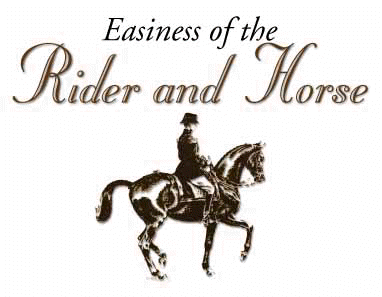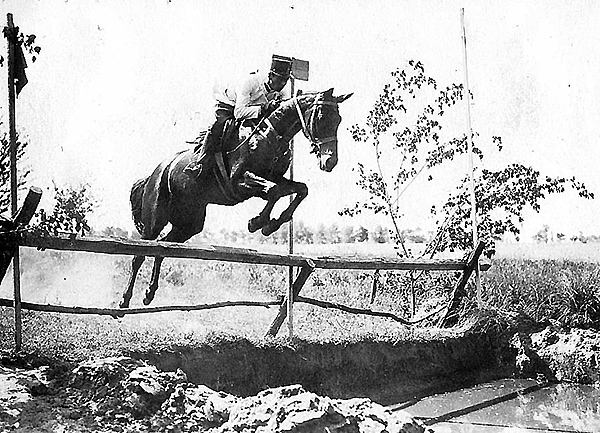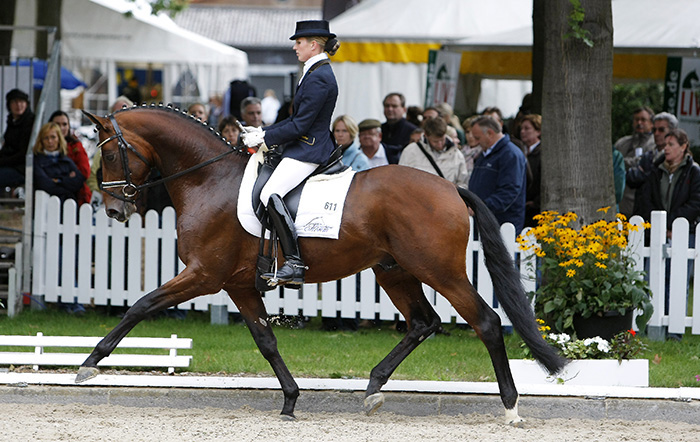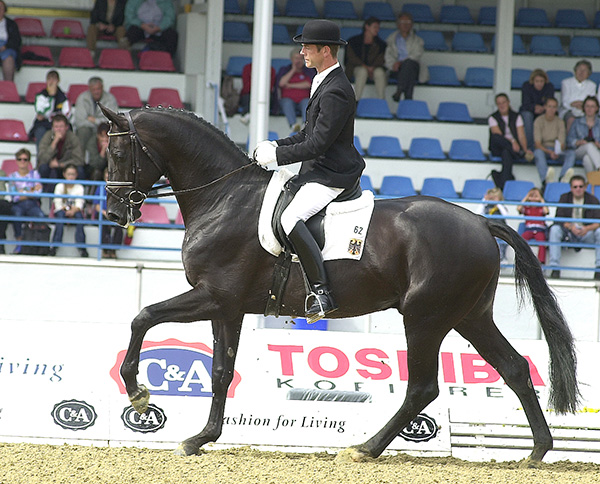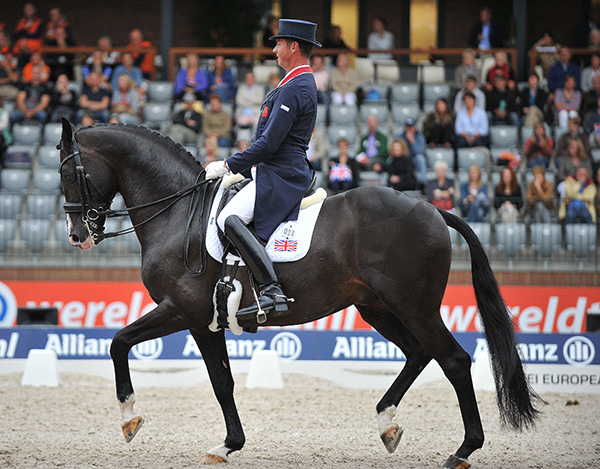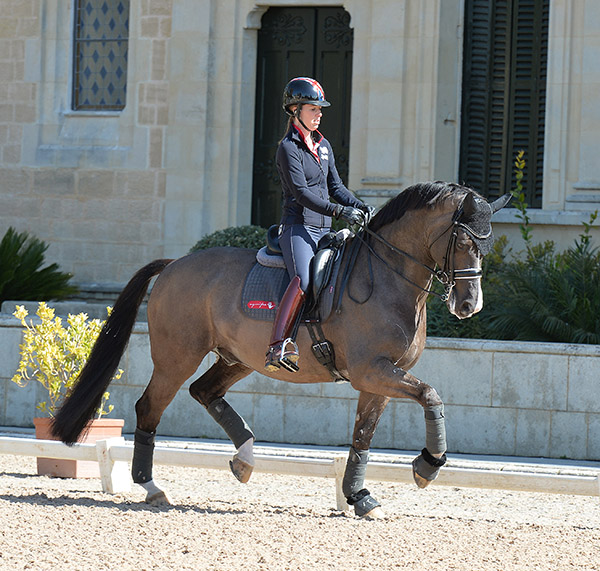The Horse Magazine printed this section from one of the forgotten classics of Equestrian Literature – Give Your Horse A Chance – by Lt. Col A. L. d’Endrödy in 2014. The author, one of Hungary’s most famous riders, an instructor of instructors, and a member of the Olympic Team, commenced work on the manuscript while a prisoner of the Russians at the end of the war, and completed it while the guest of the Duke of Beaufort at Badminton House.
Give Your Horse A Chance was re-published by J. A. Allen as part of their Allens Classic Series.
Creation of easiness is one of the most important tasks both of the rider’s and the horse’s schooling. It should be improved to the highest possible standard by painstaking exercises in accordance with the innate dexterity and inclination of the partners.
The term ‘easiness’ in general parlance is mainly used, in a fairly restricted sense, to express a certain physical lightness in the functions of rider and horse. It has, however, a more deeply rooted meaning which consists of mental and physical elements. In this sense:
Easiness is that quality of the rider by which he facilitates the smooth performance of the horse under any circumstance and on the part of the horse it means the degree of willingness and readiness with which it obeys the rider’s demands.
Easiness of the rider is the issue of the horse’s easiness, ie. its suppleness in general bearing and reactions. It does not mean detachment from the horse, cessation of a created contact, or inactivity in his conduct.
Easiness must not be mistaken for ‘lightness’ which is only a certain manifestation of this easiness.
‘Lightness’ is the yardstick of that effect of strength which is produced by the rider or the horse in keeping contact, conveying and receiving signals or aids. That which is light is not necessarily ease, and lightness without easiness has no value in riding.
The higher the rider’s capacity in combining lightness with easiness, the more energetic actions can he employ during the course of communication with the horse without endangering this easiness. Thus at first lightness has to be improved before energetic actions can be used!
The various functions, procedures and exercises described in this book are composed with special regard to ensuring easiness while the rider is employing them. Thus, during the study of the various paragraphs the reader will get an answer also to the question as to how the horse’s and his own easiness can be achieved.
Additionally it is still necessary to examine some details about the physical culture of the rider by which his activities can be endowed with easiness.
To become easy in his activities the rider should make good use of any opportunity, and perform exercises both on horse-back and on the ground which promote the lightness of his movements, flexibility of his body, and the refined control of his muscles. He should acquire the skill to perform movements in complete relaxation like a lightly waving silk cloth, but also with strength like an elastic steel spring. He should be able to change over between these two extremes with equally smooth transitions while increasing as well as decreasing the strength. Furthermore, it is necessary for the rider to become skilled in exercising functions independently, and in employing different strengths in performing them simultaneously.
Lack of easiness in the hands is the greatest disadvantage of riding, and it causes a high percentage of the difficulties encountered by the rider. Therefore it is of utmost importance to free the hands from the least rigidity.
In making them easy the procedure should start with relaxing the shoulders, elbows, wrists and all joints of the hands (fingers). Relaxation of the elbows has a special importance, since by it, the relaxation of the arms and hands is considerably promoted. Think often of it:
For this purpose perform smooth, wavy movements in which the shoulders, upper and under-arms, the hands up to the tip of the fingers participate simultaneously with, but independently from, each other,eg. make Swedish arm exercises (also on horse-back), balance a cane on the tip of one of the fingers (alternating hands), change over repeatedly the whip from one hand to the other with open, rounded movements.
In order to relax the hands themselves practise the following exercises. Write with a pencil with a very long point (about half an inch, 12 mm), until you are able to use it easily without breaking the point. do this with both hands, and also simultaneously.
Take in one hand a soft rubber ball and in the other a harder one, and exercise, sometimes only on the one and sometimes on both of them, short or prolonged pressures in rotation. Take care when relaxing the pressure that ‘contact’ is maintained. Change the balls from time-to-time and repeat the exercise.
Combine the two exercises, and write with the one hand while pressing the ball with the other.
During riding (in all paces, and also on undulating surfaces) let loose the reins and imitate writing (normal small letters) simultaneously with both hands.
Play with the fingers on the withers of the horse.
The easiness of the seat in its whole constitution is the basis for perceiving sensations conveyed by the horse’s back and for exercising proper influence on it. Therefore it is also an important task of self-education to improve and refine the sensibility and efficiency of the seat.
The motional part of self-education should start with suppling the upper body by smooth gymnastic exercises (also on the ground). Then make frequent series of moderate oscillating movements with the upper body in lateral and longitudinal directions without, however, shifting the seat from its original posture.
During the next exercises interchange in series the normal and action-ready position of the seat; the pressure by the seat with that of the thighs, and both of them with the pressure, respectively with relaxation on the stirrups.
The easiness shown by the legs manifests itself most characteristically in the smoothness with which the rider keeps them in a relaxed state on the horse’s sides. They must cleave there without clasping, and retain the contact independently from the motion of the animal.
To acquire the skill and feeling, ride in the beginning without stirrups, if possible, on a quiet, rather fat horse of comfortable paces and keep at first the legs motionless on the girth; then, during this exercise, single breathing-like pressures with alternate legs, at the same time taking care that the leg does not lose contact with the horse’s side during the moments of relaxation. Exercise slight knocks alternately with the legs; later on perform the above exercises with the use of stirrups, both in the sitting and forward position.
In order to improve the general easiness, ride often on undulating ground, and practise the recommended exercises up and down hill. The improving quality of this combined exercise lies in the fact that the rider, in order to follow the changing movements of the horse, is obliged to interchange the functions of the engaged muscles in rotation, while he performs also movements producing lightness.
The rider must also learn how to remain steady, ie. motionless on the horse’s back. This steadiness should not be mistaken for a bearing in which the body or parts of it are fixed rigidly into a certain position, since such a position will always become stiff. If, however, the rider’s bearing is relaxed and easy, such stiffness will automatically disappear.
All exercises which produce easiness and lightness in the rider’s bearing, promote at the same time his skill in adopting the correct steadiness of his hands, seat, upper body and legs. By starting the exercises with ample movements, one should gradually reduce inner vibration of the engaged muscles only. It must be stressed that if the rider is instructed to adopt steadiness before he has become mobile, flexible and completely relaxed, he will never lose his initial stiffness.
It is self-evident that the animal’s training should also be carried out in a similar manner, by employing at first comprehensive guiding movements which should be reduced later on in accordance with its development. Achievement of the capacity for invisible guidance, being the result of the rider’s easiness and the horse’s suppleness, must be a most important aim of their education. By this means the rider will be able to direct the horse by his ‘thoughts’, which will react to him smoothly, and with complete readiness.
The rider should never be too ‘cautious’ in his activities, since such behaviour can easily make him stiff. He should concentrate attention on the easiness of his activities and by remaining ‘natural’ changing them often. Such conduct is much more conducive to good and refined riding than one which is spoilt by the fear of making a mistake.
This extract has been reproduced with permission of the publishers, J. A. Allen.

